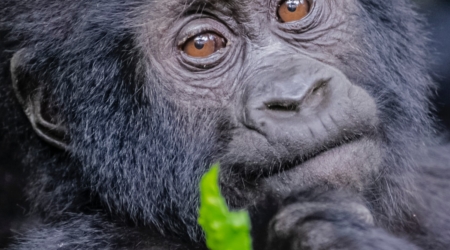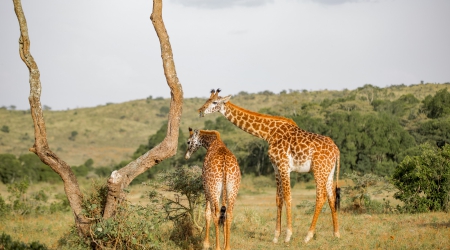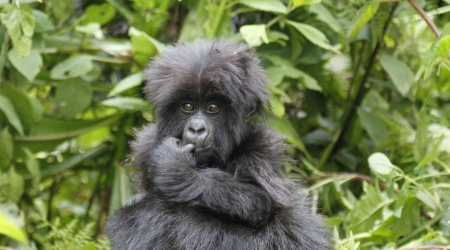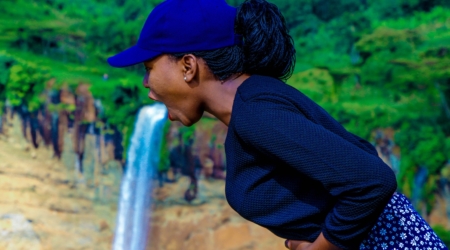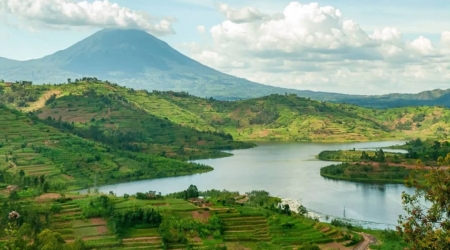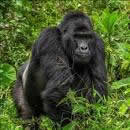Chimpanzee and gorilla trekking are two distinct primate tracking experiences conducted in the forests of Central and East Africa. Both activities involve guided hikes through tropical and montane forests to locate habituated groups of wild primates. While they share similarities in structure, the experiences differ regarding trekking dynamics, primate behavior, permit regulations, and conservation significance. Each offers a unique perspective on great apes in their natural environment, making it essential to understand their differences when planning a primate-focused excursion.
Destinations: Where Can You See Them?
Chimpanzee and gorilla trekking occur in distinct ecological zones across Central and East Africa. Each species inhabits specific forest types that influence trekking conditions and accessibility.
Chimpanzee Trekking Locations
Chimpanzees are all over Africa, but you can only find trekking experiences in protected forest reserves and national parks with habituated populations. Uganda, Rwanda, and Tanzania provide some of the most established chimpanzee trekking opportunities:
- Uganda: Kibale National Park is the primary chimpanzee trekking destination, home to over 1,500 individuals. Budongo Forest in Murchison Falls National Park and Kyambura Gorge in Queen Elizabeth National Park also offer guided chimpanzee tracking excursions.
- Rwanda: Nyungwe Forest National Park hosts a well-studied population of chimpanzees, with trekking routes passing through the montane rainforest.
Gorilla Trekking Locations
Gorillas have a more restricted range, with trekking opportunities limited to a few protected areas where conservation programs support population stability. The two primary species available for trekking are the mountain gorilla and the eastern lowland gorilla:
- Uganda: Bwindi Impenetrable National Park and Mgahinga Gorilla National Park are designated gorilla trekking sites. Bwindi is home to nearly half the world’s remaining mountain gorilla population.
- Rwanda: Volcanoes National Park offers structured gorilla trekking, well-managed routes, and a regulated permit system.
- Democratic Republic of Congo: Virunga National Park provides access to mountain gorilla trekking, while Kahuzi-Biega National Park is the primary location for tracking eastern lowland gorillas.
Unlike chimpanzees, which inhabit various forest environments, gorillas are restricted to specific montane and lowland rainforest ecosystems, often at higher elevations. As a result, trekking locations for gorillas are fewer, and targeted conservation efforts are required to maintain viable populations.
Behavior and Interaction Differences
The behavioral characteristics of chimpanzees and gorillas significantly influence the trekking experience, shaping how visitors observe and interact with each species. Differences in social structure, movement patterns, and communication styles determine engagement and predictability during trekking excursions.
Chimpanzee Behavior and Visitor Interaction
Chimpanzees are highly social primates that live in fission-fusion societies. Group size fluctuates based on resource availability and social dynamics. A single community can consist of over 100 individuals, but they split into smaller subgroups throughout the day, making their movements unpredictable.
- Social Structure: Chimpanzee groups are hierarchical, with dominant males asserting control through vocal displays, physical confrontations, and strategic alliances. Interactions among individuals are often loud and energetic, with constant vocalizations, gesturing, and social grooming.
- Movement and Observation: Observing chimpanzees requires visitors to remain mobile due to their arboreal tendencies and rapid ground movement. Chimpanzees frequently shift between the forest floor and canopy, often moving out of sight within seconds. This dynamic behavior means that sightings are fragmented, requiring trekkers to adjust their position multiple times for better visibility.
- Vocalization and Engagement: Chimpanzees communicate through various sounds, including pant-hoots, screams, and drumming on tree trunks. These vocalizations often guide trekkers toward their location and indicate an unpredictable and sometimes chaotic atmosphere during sightings.
Gorilla Behavior and Visitor Interaction
Gorillas live in cohesive family units, typically consisting of a dominant silverback, multiple females, and their offspring. These groups maintain a relatively stable structure and emphasize bonding and cooperative care of the young.
- Social Structure: Gorilla groups exhibit a calm and hierarchical organization, with the silverback as the primary decision-maker. He determines movement, feeding locations, and group safety. Unlike chimpanzees, gorilla interactions are more subdued, with social grooming, play, and quiet vocal exchanges common within the group.
- Movement and Observation: Gorillas are primarily terrestrial, moving slowly and deliberately. Once a family is located, visitors typically remain in one area, observing the gorillas from a fixed position as they feed, rest, or interact with one another. This stationary observation allows for extended and detailed viewing.
- Vocalization and Engagement: Gorillas communicate through deep grunts, chest-beating displays, and subtle facial expressions. While silverbacks may assert dominance through powerful chest beats, these behaviors are usually non-aggressive, serving as signals within the group rather than direct threats to visitors.
Key Differences in Interaction and Behavior
- Observation Style: Chimpanzee trekking is more dynamic, requiring movement to keep up with fast-paced individuals. Gorilla trekking, on the other hand, allows for longer, uninterrupted viewing due to the primates’ stationary behavior.
- Group Structure: Chimpanzees live in larger, fluid communities with complex social interactions, while gorillas exist in stable family groups with well-defined leadership.
- Vocalization and Activity: Chimpanzees are more vocal, expressive, and unpredictable, while gorillas are quieter and engage in more measured interactions.
Costs and Permit Prices
The cost of chimpanzee and gorilla trekking varies significantly due to differences in conservation efforts, permit availability, and logistical considerations. Gorilla trekking generally involves higher permit fees and additional costs due to the species’ limited population, strict conservation measures, and the controlled nature of trekking operations. While still regulated, Chimpanzee trekking tends to be more affordable and widely available.
Chimpanzee Permit Costs
Chimpanzee trekking permits are generally lower in price compared to gorilla trekking due to the higher number of habituated chimpanzee groups, their wider distribution, and lower conservation-related restrictions. Permit costs vary by country and national park:
Uganda
- Kibale National Park: $200
- Budongo Forest (Murchison Falls): $130
- Kyambura Gorge (Queen Elizabeth NP): $50
Rwanda
- Nyungwe Forest National Park: $90
Some parks offer full-day habituation experiences at a higher cost, allowing visitors to spend extended periods tracking and observing chimpanzees.
Gorilla Permit Costs
Gorilla trekking permits are more expensive due to the extensive conservation efforts required to protect mountain gorillas and the controlled nature of visitor access. Limited licenses are issued daily to minimize human impact on gorilla groups.
Uganda
- Bwindi Impenetrable National Park / Mgahinga Gorilla National Park: $700
- Gorilla habituation experience (four-hour visit): $1,500
Rwanda
- Volcanoes National Park: $1,500
Democratic Republic of Congo
- Virunga National Park: $400
- Kahuzi-Biega National Park (eastern lowland gorillas): $400
Rwanda maintains the highest permit fees, positioning its gorilla trekking as a luxury experience, while Uganda provides a more budget-conscious alternative. The Democratic Republic of Congo offers lower-cost permits but presents additional logistical challenges due to security concerns.
Additional Costs to Consider
Both chimpanzee and gorilla trekking involve costs beyond permits. These may include:
- Park entrance fees: Some locations require separate park admission fees.
- Guides and porters: While trekking guides are included in permit costs, porters can be hired for an additional fee to assist with carrying gear and navigating rugged terrain.
- Accommodation and transport: Gorilla trekking sites are often in remote locations requiring multi-day travel and specialized transport arrangements.
Key Differences in Cost Considerations
- Affordability: Chimpanzee trekking is significantly less expensive, making it a more accessible option for budget-conscious travelers.
- Permit Availability: Gorilla permits are limited and must be booked months in advance. Chimpanzee trekking permits are easier to obtain due to the higher number of habituated groups.
- Overall Expenses: Gorilla trekking involves additional logistical expenses, including higher accommodation costs and transportation to remote trekking sites.
Which One Should You Choose?
Deciding between chimpanzee and gorilla trekking depends on physical fitness, budget, personal interests, and the type of wildlife experience sought. While both activities offer unique insights into excellent ape behavior, the differences in trekking dynamics, costs, and species interactions influence which option may be more suitable.
Who Should opt for Chimpanzee Trekking?
Chimpanzee trekking is a more active and unpredictable experience, requiring visitors to move frequently to keep up with fast-moving groups. It is well-suited for:
- Those interested in high-energy wildlife interactions – Chimpanzees are highly social and vocal, displaying complex group dynamics that involve frequent calls, gestures, and sudden movements. The experience is dynamic and requires quick adaptation.
- Visitors seeking a budget-friendly alternative—Chimpanzee trekking permits are significantly cheaper than gorilla permits, making them accessible for those looking to experience primates without the high cost.
- Trekkers with moderate physical fitness – While chimpanzee trekking requires agility due to constant movement, it generally occurs at lower elevations with more manageable terrain than gorilla trekking.
Who Should Opt for Gorilla Trekking?
Gorilla trekking offers a more structured and immersive observation experience, where visitors spend extended time in the presence of a habituated family. It is ideal for:
- For those seeking a slow-paced, close-up wildlife experience, gorillas move slowly and remain in one area for extended periods, allowing for in-depth observation of social interactions, feeding behaviors, and group hierarchy.
- Visitors looking for a high-impact conservation experience – Gorilla trekking directly supports critical conservation programs, with a significant portion of permit fees funding habitat protection, anti-poaching patrols, and community development initiatives.
- Trekkers with high physical endurance – Gorilla trekking often involves steep, muddy terrain at high altitudes, requiring sustained physical effort. Visitors should be prepared for strenuous hikes lasting several hours.
Factors to Consider When Choosing
- Budget: Chimpanzee trekking is more affordable, with permits costing a fraction of gorilla trekking.
- Trekking Difficulty: Due to elevation and rough terrain, gorilla trekking is physically more demanding, while chimpanzee trekking requires agility but is less strenuous overall.
- Time Spent with Primates: Gorilla trekking offers more stationary viewing, while chimpanzee trekking involves constant movement and shorter observation periods.
- Permit Availability: Gorilla permits are limited and require booking, whereas chimpanzee trekking permits are more widely available.
For those with flexible schedules and budgets, experiencing chimpanzee and gorilla trekking provides a comprehensive perspective on Africa’s great apes, showcasing their contrasting behaviors and ecological roles. However, selecting the most suitable option depends on individual travel goals and physical capabilities.







